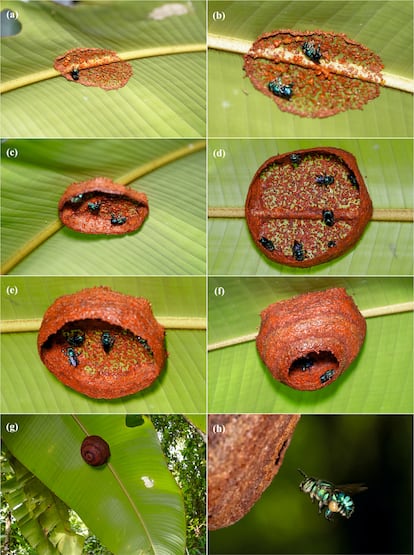Without hierarchies, males, or queen: the unprecedented matriarchy of a bee "commune" in the Costa Rican jungle

In southeastern Costa Rica, in the middle of the jungle where rebellious plants display their leaves everywhere, lives a unique hive of orchid bees that breaks with traditional hierarchies. They are the oldest daughters of a lineage that defies rigid castes. While their cousins, the honeybees and bumblebees , coexist under the strict domination of a queen, they have preferred to live freely at the La Gamba Tropical Station , according to a new study in the journal Biology Letters . This discovery challenges what was believed about the social organization of these insects.
For three years, a team of biologists led by Jonas Henske, a researcher at the University of Bochum (Germany), delved into the humid tropical landscape. There, they discovered this unexpected natural refuge: a vibrant nest of the Euglossa cybelia species, housing sixteen females. There was no mother bee dictating orders, nor hierarchies determining the fate of the inhabitants. These bees, in fact, are not bound by the complex social organization called obligate eusociality. They seem to bridge the gap between solitude and society, united in a silent pact of coexistence.

The scientists followed up on a previous analysis , which mentioned that this species was frequently found near rivers. For Henske, orchid bees are like orchids themselves: striking, diverse, and with unique behaviors. “From the moment I had my first contact with them, they captivated me,” the researcher tells EL PAÍS, who has been fascinated by these insects for over a decade. Although he specializes in the behavior of male bees—the artisans of fragrances—this time the focus was on the females.
Each of the bees cared for its own offspring, sharing the same space, a rather unusual phenomenon. “What's interesting is that they weren't all sisters. They formed groups of different lineages, which indicates that this isn't a typical family structure,” emphasizes the lead author of the analysis published this Wednesday. It's a form of coexistence, where all of them collaborate in building the nest, but each one maintains its own independent reproduction.
"The interesting thing is that they weren't all sisters. They formed groups of different lineages, which indicates that it's not a typical family structure."
Jonas Henske, University of Bochum
Pablo Vargas, a researcher at the Royal Botanical Garden, comments the same. This is a group where social species are not usually found. “Not only that, but the colony doesn't originate from a single founding female, as in typical hives, but is formed by several independent females. It's literally a commune,” says this expert, who was not involved in the discovery. Communal nesting itself can be observed in other bee species, but the communal founding of nests is unique.
Vargas draws a parallel with humans. In some traditional cultures, communes were formed where children were raised by different mothers in the community. This allowed the others more free time or to share the workload. “Something similar could be happening here,” he says.

Building a resin dome in the jungle is no easy task. Cooperation among multiple females, according to the author, could be a strategy to address this challenge, making the task more efficient than if a single bee were doing it alone. The rarity of this case is further emphasized by observing that, although all the females were mated and could produce daughters, only male offspring initially populated the nest.
In bees, males emerge from unfertilized eggs, an act of biological independence that, in this case, appears deliberate to avoid competition among sisters, as they abandon the nest when they mature. In bees and wasps, males can hatch from unfertilized eggs, but in this case, the bees had mated and chose not to produce females.
Some unknowns of the lineageFinding nests remains a major challenge. Nesting behavior has been described for only a small fraction of the more than 250 known species. Small nesting communities have been observed in some orchid bee species in Costa Rica, although they generally remain solitary. Colonies consisting of a mother female, her daughters, and other unrelated females are sometimes found. However, each female forages for her own food, and there is no recruitment system for gathering resources, as is the case with honeybees or stingless bees.
The team's next step will be to continue searching for nests, a complex task that involves weeks of work in remote areas of the jungle. "This behavior is difficult to study," says Ignasi Bartomeus, a researcher at the Doñana Biological Station. "We have to locate the nests and perform genetic analyses of the bees to see if they are related, so we know little about these relationships," explains the ecologist, who was not involved in the analysis. The goal is to mark individuals and observe whether there is interaction between nearby nests, or even whether there are chemical signals that the females use to group together.
"We want to know what factors lead them to found a nest together. Are they responding to specific odors? Is it pure chance, or is there a pattern?" the researcher asks. Scientists are still at a very early stage, but this could open up a new line of research into the evolution of insect societies.
Among the orchid bees, in this hidden corner of the Costa Rican jungle, a different society flourishes, inviting us to rethink evolution and the meaning of community living.
EL PAÍS





